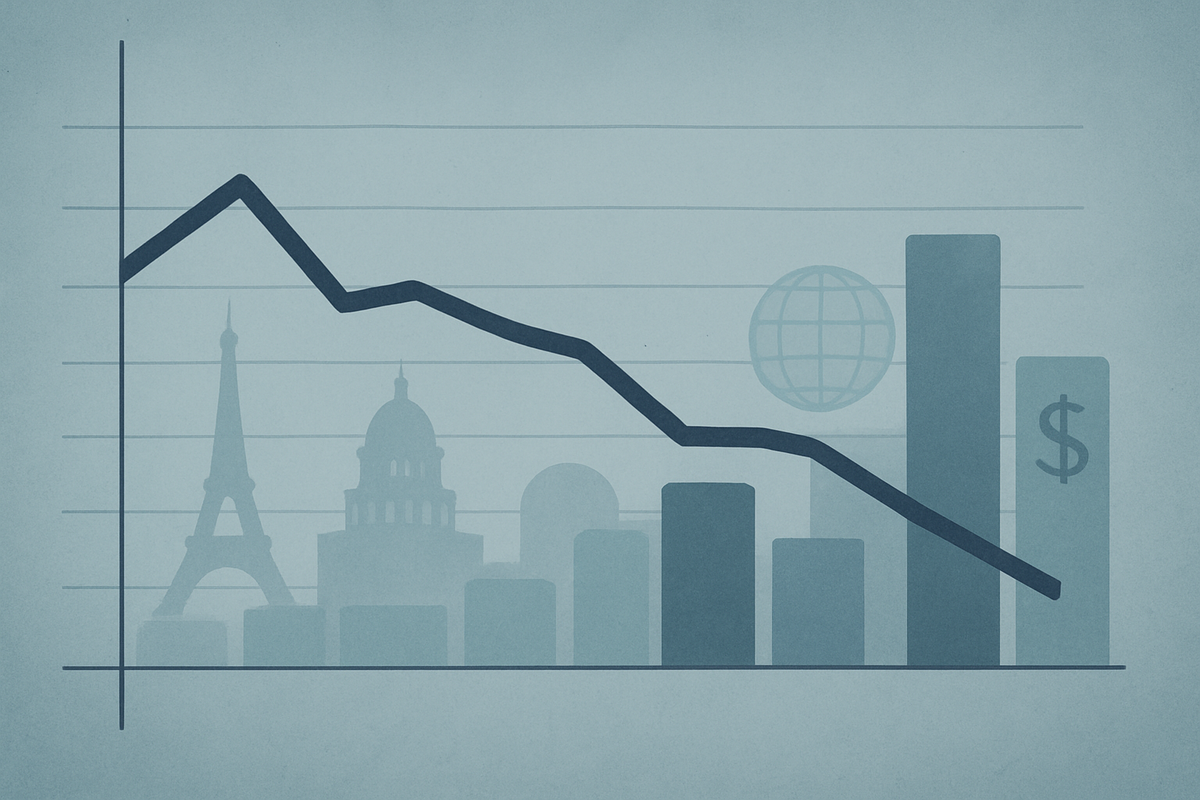
New York, NY – November 12, 2025 – Investors accustomed to the robust, double-digit returns of the past decade are being urged to temper their expectations. Investment banking giant Goldman Sachs has released a comprehensive forecast predicting a significantly slower pace of stock market growth over the next ten years, a stark departure from the recent bull run. This outlook signals a potential end to the "golden age" of easy gains, forcing a re-evaluation of investment strategies and asset allocation for both institutional and retail investors.
The immediate implication of Goldman Sachs' (NYSE: GS) forecast is a crucial shift in investor mindset. The era where broad market appreciation could reliably drive substantial wealth creation appears to be waning. Instead, the market is entering a more challenging environment where discerning stock selection, strategic diversification, and active management will become paramount. This projection not only impacts individual portfolio planning but also has wider ramifications for financial institutions, retirement planning, and economic policy.
Goldman Sachs' Sobering Outlook: A Decade of Modest Returns
Goldman Sachs' equity strategy team, notably led by David Kostin, forecasts a modest annualized nominal total return of just 3% for the S&P 500 (INDEXSP: SPX) over the next decade, extending through 2034. This projection represents a dramatic decrease from the impressive 13% annual return experienced by the S&P 500 in the preceding decade and falls significantly below the long-term average of 11%. Another forecast from Peter Oppenheimer, Goldman's chief global equity strategist, suggests a 6.5% annualized return for the S&P 500 over the same period, still considered the weakest among global regions. The firm's model even assigns a 72% probability that stocks will underperform bonds and a 33% likelihood of lagging inflation through 2034, painting a challenging picture for equity investors.
Several critical factors underpin this cautious forecast. Firstly, elevated valuations are a primary concern. The current cyclically adjusted price-earnings (CAPE) ratio stands at 38, placing it in the 97th historical percentile, indicating that high starting valuations often precede lower future returns. The S&P 500's forward price-to-earnings ratio has also surged to 23, nearing the record levels seen before the dot-com bubble. Secondly, market concentration poses a significant risk. Recent market gains have been heavily reliant on a small group of "Magnificent Seven" technology stocks. Goldman Sachs argues that it is challenging for any firm to maintain exceptionally high sales growth and profit margins over extended periods, suggesting that an equal-weight S&P 500 might deliver better returns than the standard cap-weighted index due to these concentration risks.
Furthermore, Goldman Sachs anticipates increased economic contractions in the U.S. over the next decade, forecasting four GDP contractions (or 10% of quarters) compared to just two in the previous decade. Historically, annualized equity returns have averaged -10% during such slowdowns. The firm also points to fading tailwinds that propelled the S&P 500's performance in the last decade, such as rising margins, lower taxes, and persistently low interest rates, which are unlikely to be as impactful going forward. Finally, stiff competition from other assets, particularly bonds, is expected to weigh on equity returns. While the long-term outlook is conservative, Goldman Sachs Research has a more optimistic short-term view for 2025, projecting a 10% total return for the S&P 500 (including dividends) and an 11% increase in earnings, with a target of 6,500 by the end of 2025, though this has recently been trimmed to 6,200 due to policy uncertainties and economic growth concerns.
Identifying Potential Winners and Losers in a Slower Growth Environment
In an era of decelerated stock market growth, the landscape for corporate performance and investor returns is set to shift dramatically. Goldman Sachs' analysis points to specific sectors and company characteristics that are likely to thrive or struggle.
Predicted Winners:
- Value-Oriented and Defensive Sectors/Companies: As growth becomes scarcer, investors are expected to pivot towards stability. Companies with stable earnings, robust balance sheets, and consistent dividends will likely see increased interest. This "Great Rotation" favors traditional, value-oriented investments and more defensive market segments.
- Basic Materials Sector: Goldman Sachs projects robust earnings per share (EPS) growth of 13% for the basic materials sector in both 2025 and 2026. Coupled with an attractive valuation discount compared to the S&P 500 (INDEXSP: SPX), this sector could outperform as the market re-rates these stocks.
- Artificial Intelligence (AI) Infrastructure and Related Technologies: While broader tech valuations face scrutiny, companies at the forefront of AI development and cloud infrastructure are poised for significant gains. This includes Vertiv (NYSE: VRT) and Schneider Electric (OTCMKTS: SBGSY), which are deeply involved in AI data center builds and energy management for AI demand. Data Center REITs like Digital Realty Trust (NYSE: DLR) and Equinix (NASDAQ: EQIX) are also expected to benefit from consistent demand.
- Gold Mining Companies: Anticipated U.S. interest rate cuts and sustained rallies in gold prices are expected to boost gold miners. Newmont Corporation (NYSE: NEM), a major gold producer, stands to gain significantly from higher gold prices.
- Small-Cap Equities: Goldman Sachs remains constructive on small-cap equities, citing solid fundamentals and attractive valuations relative to large caps. Their domestic focus (77% of Russell 2000 (INDEXRUSSELL: RTY) revenues from the U.S.) could also provide a buffer against global uncertainties.
- Indian Equities: Goldman Sachs maintains a positive long-term outlook on Indian equities, particularly companies benefiting from domestic growth, strong pricing power, and export-oriented businesses, driven by mid-teen earnings growth expectations.
- Software Sector (with caveats): The software industry is forecast to grow EPS by 10% and 14% in 2025 and 2026, respectively, with AI spending fueling gains. However, high valuations (68% premium to the S&P 500) present a risk, meaning only companies with sustained innovation and clear AI integration strategies are likely to succeed.
Predicted Losers:
- High-Growth, High-Valuation Technology Stocks (Excluding Core AI Infrastructure): Many high-flying tech stocks, particularly those outside of core AI infrastructure, may face increased scrutiny. If corporate earnings growth fails to meet elevated expectations, these companies could experience significant pullbacks due to their stretched valuations. The high market concentration of the S&P 500 in these few giants is also a risk.
- Companies Highly Sensitive to Economic Slowdown and Tariffs: General economic slowdowns, higher tariffs, and reduced consumer spending are expected to weigh on profitability. Companies with less robust balance sheets, lower pricing power, or significant exposure to international trade and consumer discretionary spending will likely see reduced profitability and tighter margins.
Broader Implications and Historical Parallels
Goldman Sachs' forecast of subdued stock market growth over the next decade isn't an isolated prediction; it aligns with a broader sentiment among some financial institutions that the "easy-money era" is drawing to a close. JPMorgan (NYSE: JPM) also projects more modest global equity returns of 6-7% annually, advocating for diversified portfolios that include alternative assets. This suggests a market entering a "range-bound" phase, characterized by rallies and pullbacks without a clear, sustained upward trajectory.
The implications ripple across the financial ecosystem. Investment banks and asset managers are likely to face reduced profitability due to lower trading volumes, decreased commission revenues, and slower growth in assets under management (AUM). This could impact firms like BlackRock (NYSE: BLK) and Vanguard, potentially leading to tighter fee structures and a greater emphasis on performance in a challenging environment. Fintech companies might see a deceleration in capital flows, particularly in digital assets, and financial planning for small and medium-sized enterprises (SMEs) could become more complex. For corporate clients, weaker earnings growth and difficulty securing affordable financing could curb investment and profits, potentially leading to lower dividend payouts or credit rating downgrades. Most significantly, for consumers and retirement planning, prolonged slower growth means smaller retirement funds, potentially leading to a "reverse wealth effect" and reduced consumer spending, further dampening economic growth.
From a regulatory and policy perspective, a period of slower growth and heightened volatility could prompt various responses. Central banks, like the U.S. Federal Reserve, may need to adjust interest rate policies to balance inflation control with supporting economic growth. Governments might consider fiscal policy changes, such as tax rate adjustments or government spending, to influence business profitability and investment. Increased market volatility and concentration risks could also lead to calls for new regulations aimed at market stability, investor protection, or addressing systemic risks, potentially impacting how exchanges like the New York Stock Exchange (NYSE: ICE) and Nasdaq (NASDAQ: NDAQ) operate.
Historically, periods of high valuations coupled with catalysts like interest rate hikes or economic slowdowns have often preceded significant market pain. "The Lost Decade" (2000-2009), following the burst of the dot-com bubble and exacerbated by the Global Financial Crisis, saw the S&P 500 deliver negative annualized returns. Similarly, the "Stagflation Grind" of 1968-1979, characterized by rampant inflation and stagnant markets, eroded real returns significantly. These historical precedents serve as a cautionary tale, suggesting that the current environment, with elevated valuations and potential shifts in monetary policy and trade, could lead to a new, more constrained market reality.
Navigating the Road Ahead: Strategies and Scenarios
The coming years will demand a proactive and adaptable approach from investors. Goldman Sachs' forecast outlines both short-term possibilities for 2025 and longer-term challenges, necessitating strategic pivots.
In the short-term (2025), Goldman Sachs expects the market to continue making progress, with the S&P 500 potentially reaching 6,200 by year-end, driven by corporate earnings growth of 11% in 2025. They anticipate three Federal Reserve rate cuts in 2025, signaling cooling inflation and moderate economic growth. However, this optimistic outlook is "priced for perfection," making global equities vulnerable to corrections if bond yields rise further or economic/earnings data disappoints. A 10-20% market drawdown within the next 12-24 months is considered a likely scenario.
For the long-term (next decade), the primary outcome is significantly lower equity returns, with bonds potentially outperforming stocks. U.S. equities are expected to lag global peers, with annualized returns of 6.5% for U.S. stocks in USD terms, significantly below the 10.9% forecast for Emerging Markets and 10.3% for Asia ex-Japan.
Strategic pivots and adaptations required include a strong emphasis on geographic diversification, particularly into non-U.S. assets like emerging markets (e.g., India and Asia ex-Japan) due to their higher growth potential and lower valuations. Investors should also consider the S&P 500 equal-weight benchmark (NYSEARCA: RSP), which is expected to outperform the cap-weighted aggregate index. A focus on "quality compounders"—companies with steady profit growth throughout economic cycles—and stocks with stable earnings growth will be crucial. Given potential volatility, hedging strategies using options can help protect against downside risk. Finally, reduced credit exposure by shifting from corporate debt to Treasuries is advised.
Market opportunities may emerge in sectors like basic materials and software (driven by AI), and in specific consumer sectors in India. Drawdowns could also present buying opportunities if economic fundamentals remain sound. Goldman Sachs also forecasts a pickup in Mergers & Acquisitions (M&A) activity in 2025, with an estimated 750 completed U.S. M&A transactions above $100 million, a 25% year-on-year increase. However, challenges include persistently high U.S. equity valuations, market concentration risks, slower economic and earnings growth, policy uncertainty (especially tariffs), and interest rate sensitivity. Goldman Sachs assigns a 20% probability of a recession in the next 12 months, which typically sees substantial declines in equities and earnings.
The New Investment Paradigm: A Call for Prudence and Diversification
Goldman Sachs' forecast for slower stock market growth over the next decade marks a pivotal moment for investors. The era of double-digit annual returns, largely fueled by expanding valuations and low interest rates, is likely drawing to a close. This necessitates a fundamental shift in investment strategy, moving away from an overreliance on broad market appreciation and highly concentrated U.S. large-cap growth stocks.
The market moving forward will likely be characterized by increased volatility, tighter margins, and a greater need for active management. Investors can no longer afford to be passive. The lasting impact of this forecast will be a permanent shift towards a more discerning investment environment where fundamental analysis, risk management, and strategic diversification across geographies and asset classes become paramount. The potential for persistent inflation and higher interest rates will continue to shape market dynamics, making bond yields and central bank policies critical watchpoints.
In the coming months, investors should closely monitor economic growth and inflation data, Federal Reserve policy decisions and bond yields, and any developments in trade policy, especially targeted tariffs. Corporate earnings reports will be scrutinized against optimistic expectations, and market breadth should be observed to see if leadership broadens beyond the "Magnificent Seven." Opportunities may lie in bonds as a safer alternative, specific commodities like oil, and diversified exposure to European and emerging market equities. The overarching message is clear: the investment landscape is evolving, and prudence, adaptability, and a global perspective will be the keys to navigating the decade ahead.
This content is intended for informational purposes only and is not financial advice





